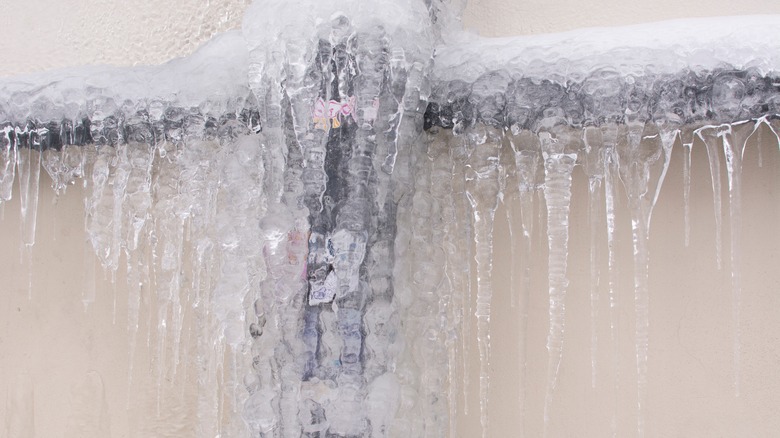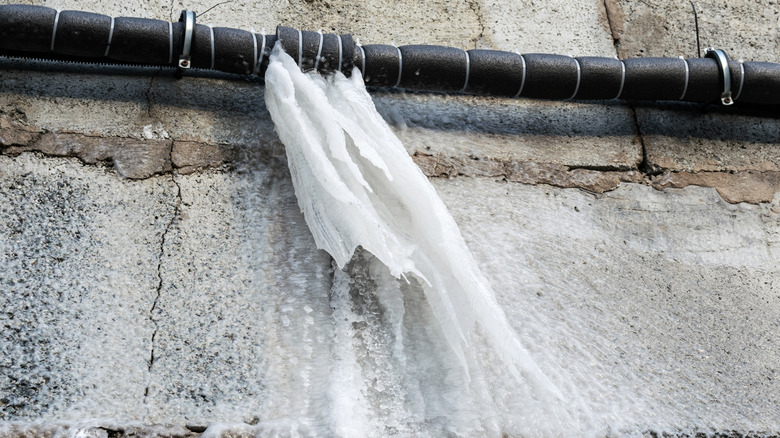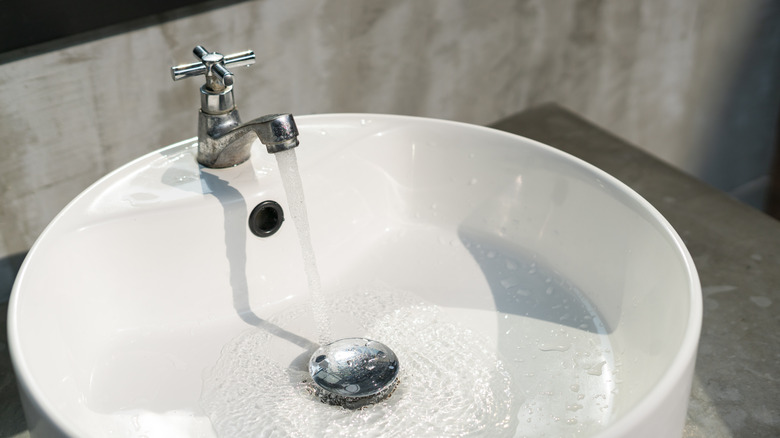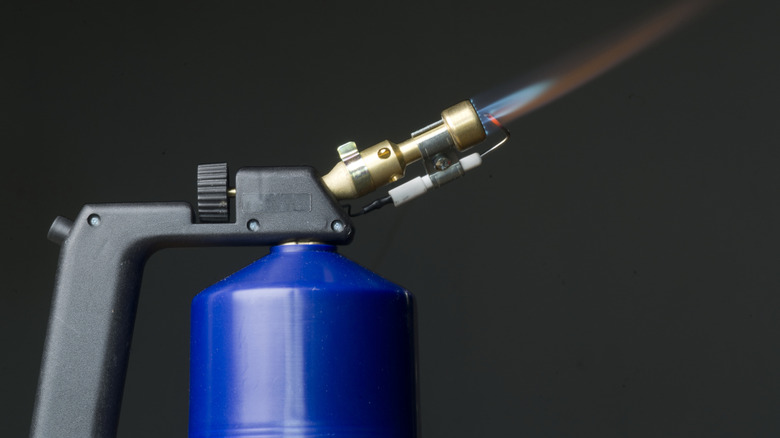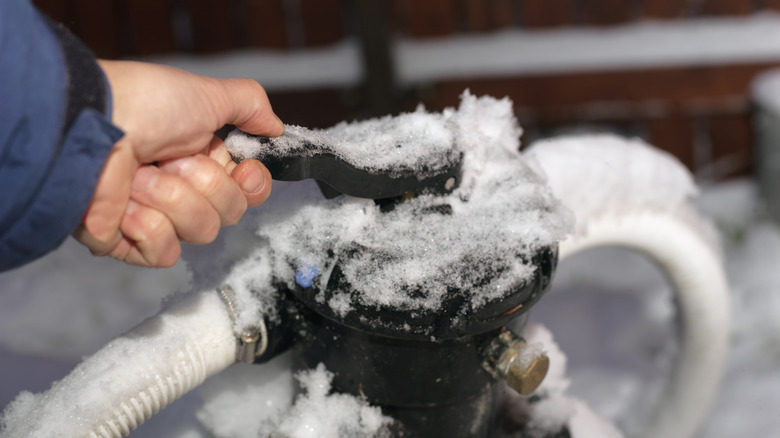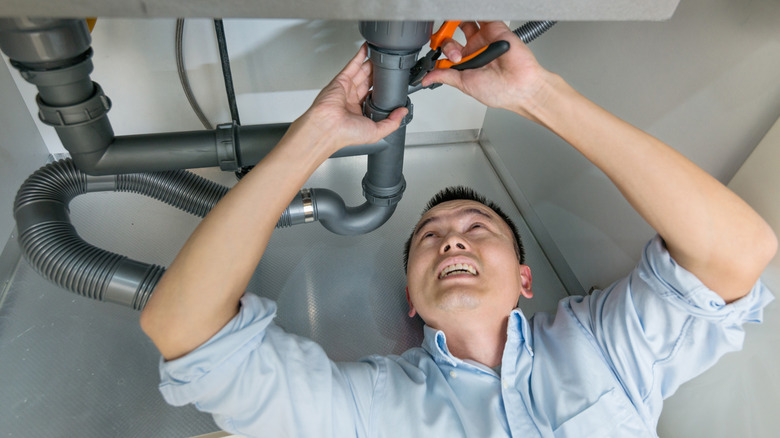Mistakes Everyone Makes When Dealing With Frozen Pipes
Winter often brings to mind images of warm blankets, hot cocoa, and enchanting snowfall that make you want to relax. The season's charm, however, can quickly fade and become a mess of frustration when you're faced with the reality of frozen pipes. These may seem like common and minor problems, but they can definitely wreak more havoc — like severe water damage — on your home's plumbing and interior, especially if left unchecked. In fact, burst pipes from freezing temperatures account for millions of property damages with State Farm paying at least $181 million for over 9,000 claims in 2022 alone.
Frozen pipes usually happen when temperatures drop below 20 degrees Fahrenheit. Prolonged periods of freezing weather, meanwhile, can also increase the chances of your pipes freezing if they are not protected enough for winter. This reality makes it essential to address frozen pipes immediately. But be warned, though, that making common mistakes while attempting to thaw them can be counterproductive and even dangerous. Taking the right steps and avoiding these errors when dealing with frozen pipes can save you from wasting time and money. You can protect your home and yourself too from future headaches — like wondering if burst frozen pipes are covered by your homeowners insurance — while enjoying a safer and more comfortable winter season!
Not turning the water supply off immediately
Shutting off the water supply is one of the most critical first steps when you are dealing with frozen pipes. Not doing so could leave you dealing with disastrous consequences once the water inside starts flowing again, such a the possibility of a cracked or burst pipe from a build up of pressure. Who wants to deal with repairing water damage while trying to fix frozen pipes at the same time?
You can avoid being in this situation if you just remember to turn off the water supply valve as soon as you suspect there is a frozen pipe in your home. This valve is typically located near the water meter or at the entry point of the main water line. This precautionary step not only lessens the risk of water damage when the pipe thaws, but can also ensure that you know the location of your shutoff valve before winter begins to save time during an emergency.
You definitely don't want to be among homeowners committing this error often and then finding themselves dealing with water-soaked floors, ruined furniture, and costly repairs. In fact, the Insurance Information Institute states that water damage and freezing is the second most cited reason for homeowners insurance claims between 2018 and 2022. The average homeowner claimed $13,954 for damages in the same period. You reduce your chance of becoming part of this statistics just by the simple step of turning off your water supply promptly.
Not opening the faucets before thawing frozen pipes
Another frequent mistake committed by homeowners is neglecting to open the faucets connected to frozen pipes. This step is important since it allows pressure to escape the pipe as the ice melts. If the faucet is left unopened, then the pressure inside the pipes caused by trapped melted water can lead to bursting or exploding. To avoid this, just remember to turn on both the hot and cold handles of the connected faucet when you try to locate the affected pipe. This small but crucial action creates a release point for the water and prevents the buildup of pressure.
Aside from preventing damage, opening the faucet can also provide a visual cue to monitor progress when you're dealing with frozen pipes. As the ice begins to melt, you'll notice a trickle of water coming out. This indicates that the pipe is thawing and you're doing the proper steps. Just take note that patience is key and forcing the process or ignoring the need for pressure release can lead to bigger problems.
Attempting to thaw with an open fire
It's understandable that we all panic when we're faced with frozen pipes. Unfortunately, many homeowners resort to using extreme heat sources, such as open flames, in a bid to restore running water immediately. While it may seem like the quick solution, this approach is actually extremely dangerous and could lead to more headaches.
Using blowtorches and other sources of open flames poses a significant fire hazard, especially in confined spaces or near flammable materials. The extreme heat can deliver temperatures far beyond what is safe for pipes. This may lead to these frozen pipes to not just thaw, but actually crack or bust too. Doing this method also risks damaging the surrounding areas, such as walls and insulations, among others.
You may instead decide to use safer tools or methods like using a hair dryer, heating pad, or warm towels. But always ensure that these items are used according to their safety guidelines to prevent accidents. An example is that you should never leave a heating pad unattended or use a hair dryer near water.
Heating the frozen pipes quickly and intensely
Yes, you might be using safer heat sources when dealing with frozen pipes in your homes. But even so, many people still make the same mistake of applying heat too quickly or intensely. This means that you immediately use a high temperature or make uneven moves in applying the heat. It is also important to note that sudden temperature changes can weaken the pipe material that may already be compromised or damaged by freezing. Doing so can lead to small cracks that may go unnoticed until it's too late.
Therefore, it's crucial that you thaw a frozen pipe safely, and this can be done by gently applying consistent heat. You can start by warming the area closest to the faucet before gradually moving along the frozen pipe. A space heater placed a safe distance away or a hairdryer set on low can work well for this purpose. Remember to avoid rushing the process since slow and steady thawing minimizes the risk of damage.
It is also essential that you monitor the progress of thawing the frozen pipes. Check the pipe's condition frequently and listen for any unusual sounds as you go through the process. These sounds — cracking or hissing — could indicate a problem and being proactive can help reduce the likelihood of causing additional damage. But if you are unsure of how to proceed, then it is best to consult a professional plumber, so that you avoid putting your home and safety at risk.
Not checking pipes for leaks after thawing
It's all too common that homeowners assume that the job is done once the pipe is thawed and water flow is restored. Failing to check for leaks in the pipes, however, can lead to significant water damage over time. Remember that cracks or weak spots may have formed during the freezing process, even if they're not immediately visible.
You can prevent future headaches by immediately inspecting the entire length of the pipe for any signs of water seepage or dripping. Don't forget to pay close attention to joints and connections since these are common weak points. Immediately turn off the water supply again if you find the leak to avoid flooding. You can also do temporary fixes like pipe tape or epoxy putty for short-term solutions, but should not replace professional repair, especially if you're not sure of the process.
It's also best to keep an eye on your water meter after restoring water flow. Check if there's an unusually high increase in your reading, since this could indicate a hidden leak. But beyond this, don't forego regular maintenance and vigilance, which are important in preventing further issues and safeguarding your home from costly repairs!
